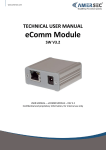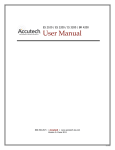Download Basic Installation Rules AMERSEC EAS Systems
Transcript
AMERICAN SECURITY USER MANUAL – RULES OF INSTALLATION Basic Installation Rules AMERSEC EAS Systems This document is meant to describe basic rules of installation and can be applied to all Amersec EAS systems. EAS is a special technology and relies on strong signals passing through the environment with as little interference as possible. By following some basic rules, the installation can be greatly improved in terms of time spent at the site, performance of the systems, and post-installation maintenance. While this document is definately not exhaustive of all scenarios and experience in EAS is the best teacher, these recommendations are useful for any EAS installer. BEFORE YOU INSTALL 1) 2) 3) 4) 5) 6) 7) 8) Check the contents of the boxes – antennas, PC boards (and their frequency), power supplies, etc. Set up the system in your office and check its functionality prior to any installation. Take a spare antenna, power supply, and PC board(s) with you in case you need to exchange one of the items. When installing RF Dual Easydet, take a spare set of RF Dual Superdet PC boards with you. In the case that there is interference in the environment that is changing throughout the day, then the automatic feature of Superdet might be more suitable. When installing RF Dual Superdet, take a spare set of RF Dual Easydet PC boards with you. In the case that there is large interference in the environment, Easydet may work better as it is less sensitive. Take the appropriate manual(s) with you to the installation. If software is needed for tuning the system, make sure you have downloaded the latest version from the American Security website. Also, make sure you have the required hardware key. Inform your customer of the following: - It is absolutely neccessary that no tags or labels are placed near the system. The store personnel should regularly check shop windows for tags, especially when displaying new products. If there is a tag near the EAS system it may false alarm with any changes of environment (people coming in, doors opening, touching, etc.). The solution is to move all tags away from the system. - Tags placed near the power supply or cables can also cause false alarms – do not keep tags near the cables! - If installing label deactivators, rolls or sheets of labels should not be placed on the deactivator pad! The entire roll or sheet will likely be deactivated. - If the store will be using AM labels, these labels are very sensitive to bending. Store personnel should take great care in placing the labels on products. Slight bending of the labels will cause them to be deactivated. ON-SITE 1) Before drilling any holes, set up the antennas in the store exactly at the point where they will be mounted and test the functionality. The system should be tested for at least 20 – 30 mins for any false alarms, detection distances, etc. 2) When installing dual systems (2, 4, 6, etc. pcs of antennas) it is highly recommended to place the TX (transmitter) closer to the source of power or other manufacturer’s EAS system rather than the RX (receiver is more vulnerable to interference from these sources). Also interchange TX and RX in search of the best TEL: +420 271 960 054 FAX: +420 271 770 732 SUPPORT: +420 296 150 610 [email protected] www.amersec.com Page 1 of 5 AMERICAN SECURITY USER MANUAL – RULES OF INSTALLATION 3) 4) 5) 6) 7) 8) 9) 10) 11) 12) 13) 14) performance as sometimes it makes surprisingly big differences, especially when the level of interference or noise is high and its source is unknown. If the deactivator is installed close to a dual EAS system it is recommended to place the TX on the side closer to it and thus lower the interference in RX. Cables should always be led separately and at the shortest possible distance. Cables should be placed away from any power or network cables. When longer distances for cabling are required it is neccessary to use thicker cables/twisted cables, otherwise you could lose voltage and thus power (when using thin cables the output power at the end of long cables is less than at the input – example: at the input you would have 24V and at the output 22V). IMPORTANT: No 220/230V cables should be close (or touching) to your cables, especially when coiled (twisted together)! They are usually placed near tills (cash registers) at points of sale. If you have interference or noise in the environment you can use a ferrite ring placed on the power cable very close to the board (mainly receiver) to eliminate or lower the effect of the interference on the EAS system (only 24V DC). REMARK: For best results make some loops of the power cable on it inside the antenna near the power input of the board. Try to find a dedicated power line in which to plug in the system. If the system is powered by the same supply as many other devices, the power signal will not be clean and noise can be picked up by the power cables. Do not place the EAS system close to any device powered by a pulse power supply (switching power supply). Such devices may cause interference to the system which will result in lower sensitivity. When installing a system next to any metal wall, metal frames or a mirror, place the antenna at least 20 cm from the wall/mirror. If you do not keep this distance the system will automatically reduce sensivity (= worse detection). The EAS system should be installed as far as possible from any computer or backup power supply unit. Their switched power supplies do cause interference and may cause the system to reduce sensitivity automatically. When installing multiple two-antenna systems (duals) in a store where distances between the TX/RX pairs vary it is important to set the TX power correctly. Reduce TX power on the system with shorter distance between the two antennas. Avoid leaving excess power cable coiled up either near the systems or near the power supply. The cable should always be cut and shortened to the appropriate length. Excess coiled cable can cause resonance to the system. When bolting the antennas to the floor, make sure to always use large washers under the heads of the bolts. This ensures that the antenna will be more securely fastened to the floor and helps avoid loose antennas in the future. Long bolts will also be more secure. If resonance, noise, or interference is a serious problem to the system and cannot be eliminated, you may need to install a different frequency or different technology altogether. If using RF 8.2MHz technology, the most resistant system is Dual Easydet in two-crossbar antennas. In places where two dual systems are separated by a barrier/wall smaller than the gap between the two systems, it is important to place either transmitters or receivers near the barrier (see figure below). A) B) RX TX TX RX TEL: +420 271 960 054 FAX: +420 271 770 732 SUPPORT: +420 296 150 610 [email protected] www.amersec.com TX RX RX TX Page 2 of 5 AMERICAN SECURITY USER MANUAL – RULES OF INSTALLATION The configuration with receivers on the outside (A) is suitable when there is no interference in the environment. Its advantage is that the synchronization cable lead between transmitters does not need to be long. Option B is more suitable when interference is present. By placing the transmitters on the outside you will reduce the effect of interference on the receivers. RESONANCE – RF SYSTEMS Resonance that is present at some places of installation basically simulates a signal from a tag or label and therefore can cause false alarms to the EAS system. Prior to anything else, try to find the source of resonance. If you do not succeed you can try to fix the problem by reducing sensitivity on the RX board (or switch to automatic regime). Sometimes resonance is so strong that it is not possible to reduce sensitivity any further. In this case you can try to reduce TX Power. By reducing TX Power, the system will emit a weaker signal that may cause less resonance from surrounding devices. You can try to tune out the resonance by using an oscilloscope on the RX. If resonance is at the edge of the sweep frequency range (not on 8.2 MHz but at a higher or lower frequency), you may eliminate it by reducing the sweep range on the TX board or by changing the system’s center frequency. However, if the resonance is on 8.2MHz nothing can be done and the only option is to find its source and eliminate it. Some methods are; tighten screws on the doors, dismantle the handle, connect door frame to the door by a cable = grounding, etc. 1) Aluminum Racks - Aluminum or steel racks placed close to the EAS system can form a “tag” that will cause false alarms every time it moves (even very slightly). The solution is to isolate the vertical bar or completely remove it so that the racks do not form a closed electrical circuit. If possible install the system further away! 2) Touching Effect - Touching the system with bare hands can cause a false alarm. The reason is that a distant source of resonance (which normally does not interfere with the system) can lead the signal close to the antenna via your body. The solution to this is to reduce sensitivity, change sweep, or set “Caddy” so that the EAS system does not false-alarm in such cases. 3) Metal Banister (Staircase) - Can also be a source of resonance. Mainly in cases when it moves slightly or someone is touching/standing on it at the same time being close to the EAS system. We recommend to install the system as far as possible or reduce sensitivity. 4) Door Handles - May simulate a “tag” and cause false alarms when opening/closing. Try to place the system as far as possible or isolate the closed circuit by cutting the handle and placing a silicone isolator in between. 5) Metal Doors - To find the source of resonance on metal doors is usually very difficult. The best solution is to install the system as far from the doors as possible. When this is not possible you can try the following: a) tighten screws b) dismantle the door handle c) isolate the door handle d) ground the doors or door posts e) You can change the sweep frequencies on the TX board and reduce TX power. Setting the “Caddy” mode can eliminate false alarms when opening/closing the doors BUT be aware of the fact that at the same time the system will not detect a tag, either! 6) Metal Shutters - A common source of resonance. To prevent false alarms install the system at least 20 cm away from the shutters. You can also set “Caddy” so that the system does not alarm when the shutters are moving. In case the system still reacts to shutters you can reduce sensitivity or switch to fast memory mode so the system remembers this source of resonance and ignores it in the future. 7) Moving Racks, Stands or Stationary Racks mounted on the walls - They usually form closed electrical circuits that may cause resonance and therefore false alarms. As such “circuits” are very large, their movements even at a distance of 3m or sometimes more may cause resonance trouble to the EAS system. The best solution is to TEL: +420 271 960 054 FAX: +420 271 770 732 SUPPORT: +420 296 150 610 [email protected] www.amersec.com Page 3 of 5 AMERICAN SECURITY USER MANUAL – RULES OF INSTALLATION have them as far as possible from the installed system. If that is not possible you should find the exact source of resonance and isolate the “circuit” or tighten the screws. REMARK: When installing mono 1.95MHz (or other low frequency mono), LCD monitors and TV sets may also cause resonance! Systems must be at least 20cm away from these devices. Otherwise, low-frequency systems are usually quite resistant to resonance. 8) Coils of Wire/Cables – If wires or cables are coiled up near the system, they can act as a “tag” and cause resonance to the system. The solution is to straighten any wires or cables to remove the loops. 9) Other RF Systems – Can simulate resonance and cause false alarms if they are transmitting at the same frequency. The solution is to check for any nearby RF systems and synchronize accordingly. Shortwave radios can produce the same effect, but it is usually difficult to find the source or eliminate. NOISE – RF SYSTEMS Electrical noise is usually not so serious to the RF system as resonance. It is basically the addition of smaller, high frequency signals on top of the normal signals. It is sometimes easier than resonance to find and eliminate, but can still present problems to the system if the source is unknown and the noise level is high. If the source cannot be found, the sensitivity of the system may need to be decreased or the positions of RX and TX antennas reversed. If the noise level is quite high, the system will “blank” and not work at all. In this case it will be necessary to reduce “Noise” until the blanking LED is off or blinking. If noise is a problem, ferrite rings should always be added to the power cables. A simple solution that sometimes works is to just plug the power supply into a different outlet. If the power supply is plugged into an outlet with many other devices, they can introduce noise into the power cables. Other cables in the walls, floor, or near the power supply cables can also add noise to the system. Using shielded cable may help reduce the noise in this case. If noise is still a problem, all electrical devices near the system should be turned off to try to find the source. INTERFERENCE – AM SYSTEMS Acousto-Magnetic systems can also be affected by interference from the environment, and similar steps should be taken to reduce the effect if the source cannot be found. Reducing sensitivity, interchanging RX and TX antennas, and moving antennas closer together are all steps that should be taken to reduce interference. Using a different configuration of antennas and making sure the system has a dedicated source of power are also good for reducing interference. 1) Other AM Systems – Nearby AM systems will interfere with the AM system if they are not synchronized. It is ABSOLUTELY NECESSARY to synchronize ALL AM SYSTEMS, including the Amersec AM system! The solution is to synchronize the systems as directed in the manual. 2) LCD Screens – Screens from LCD TVs and computers can cause interference to the AM system. The orientation of the screen will also be important. When using a laptop to tune the AM system, make sure that it is not causing interference. Install the system as far as possible from any LCD screens or move the screen to a different location. 3) Power Cables – Cables in the floor, ceiling, and walls can affect the system. This is a common source of interference especially in old shopping centers, where a large number of cables have been placed in the same location over time. Unfortunately it can also be hard to eliminate. Place TX antennas near any walls that may have power cables or electrical devices inside. Make sure that the TX and RX cables for the antennas are away from any other cables. If the problem cannot be resolved then the sensitivity of the system must be reduced and the antennas moved closer together. 4) Halogen Lights – Sometimes used for window displays, large halogen lights can cause interference. Place the TX antenna nearest to the lights or move the lights if possible. TEL: +420 271 960 054 FAX: +420 271 770 732 SUPPORT: +420 296 150 610 [email protected] www.amersec.com Page 4 of 5 AMERICAN SECURITY USER MANUAL – RULES OF INSTALLATION 5) Electric Motors – Motors used in sliding or revolving doors and escalators can produce an electric field that causes interference to the antennas or cables. Usually it is not possible to move these devices, so the solution is to move the system as far away as possible, put the TX antenna nearest to the motor, and/or reduce system sensitivity. 6) Switching Power Supplies – Will cause interference to both RF and AM systems by introducing pulsed signals into the antennas or cables. Move the power supplies away from the system and any cables used by the system. Version 2.1 21 October 2009 TEL: +420 271 960 054 FAX: +420 271 770 732 SUPPORT: +420 296 150 610 [email protected] www.amersec.com Page 5 of 5





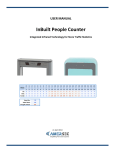
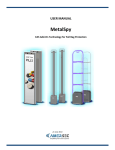
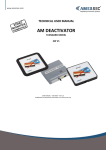
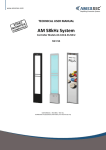
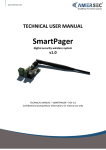
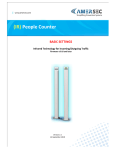

![UK User`s Manual [ Notebook ]](http://vs1.manualzilla.com/store/data/005694610_1-ad8e24898a53e900e9c2a73fa8f500a7-150x150.png)
